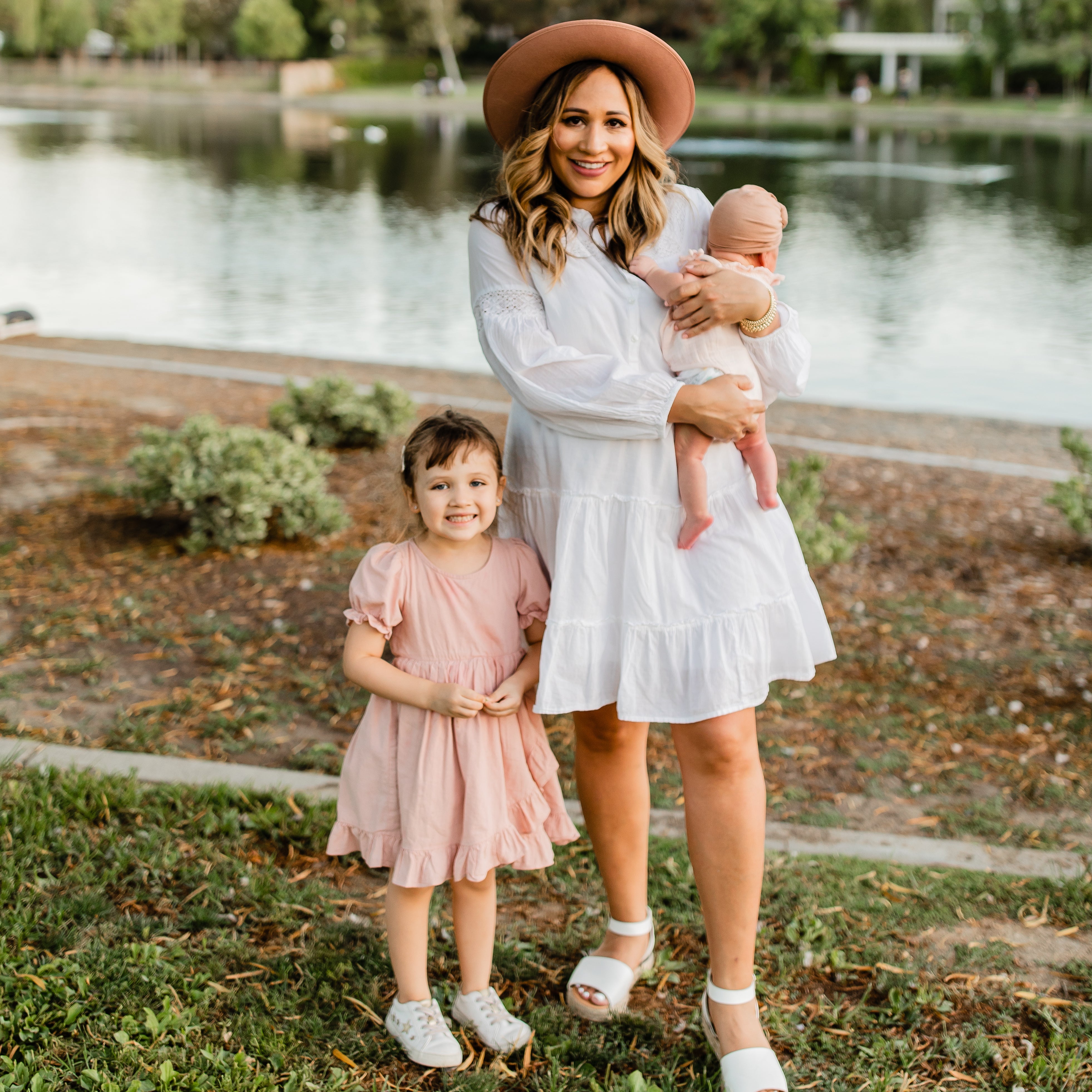
A Conversation with Corky Harvey, IBCLC & Callan, Editor
Corky Harvey, MS, RN, IBCLC is the co-founder of The Pump Station & Nurtury®, the first new parent resource center of its kind in Santa Monica, CA. She is a registered nurse with a master's degree in maternal/newborn nursing, a certified Happiest Baby on the Block educator, and was a long-time Childbirth Educator.
In part two of our interview series, she and Motherhood Editor Callan, who was nursing her 15-month-old daughter, chat about exclusive pumping, breast pump & flange basics & breastfeeding advice.
CALLAN: So why might some women choose to exclusively pump?
CORKY: It’s called EPing - exclusively pumping. Some women do it because they can't get the babies to latch. Some women just like it better because it's more convenient to them. Some women like to know how much milk their babies are getting. So there's a variety of reasons why.
I have a woman in my support group right now doing it because her baby is tongue tied, which did not get fixed, and the baby could not remove milk properly from the breast and was losing weight. So, she went to EPing. Another mother chose to exclusively pump because her baby never latched effectively. Exclusively pumping is tricky, but for some women, it's an answer and we support them fully.
CALLAN: Do you have a recommended pump or do they all kind of work equally?
CORKY: We do have several that we like the best. Know that none of the pumps coming out of insurance companies are equal to what we call the clinical grade pumps. So, the best clinical grade pump is the Medela Symphony. I beg mothers in support groups who have low supplies to please go rent a Symphony because it is more effective. I'm not mechanical enough to tell you all the ins and outs of it, but it is the smoothest, quietest, most wonderful pump on the planet. So, anybody with a milk supply issue, a breastfeeding issue, or twins or babies in the NICU should be on the clinical grade pump. Ameda is also a good clinical grade pump. Some of those little pumps say they’re hospital grade, but the FDA would disagree with that. Spectra is not clinical grade, but it is a wonderful pump.
And Medela has a new pump that's awesome. It's called the Freestyle Flex. It’s not coming through the insurance companies yet, but many mothers can get a voucher or pay a little extra money and get it. In-bra pumps are important for some women who could not otherwise pump at all - say they're in a workplace where they could do the in-bra pump - but I would use them as a supplementary pump.
CALLAN: Flanges…these was super confusing to me when I first started pumping because of the sizes. This is the same thing with the nipple shields, so how do I know what size I am?
CORKY: We do have a piece that one of our consultants wrote that I think is really helpful. We really dislike going down to 15 and 18 milimeters...even twenty ones for me. I almost never recommend them because here's the thing: if your nipple is stuck and the pump sucks right on your nipple or nipple base, it can't remove milk. Remember that a baby needs to have their jaws higher on that breast, if they're right on the nipple, they cut off their supply. So, I have seen women lose their milk on these smaller sizes of flanges. I think mothers should have a variety of sizes, play with them a little bit and see what works most effectively for them. I even think switching it up a little bit occasionally. So Medela has always come with 24mms, but easily you can buy 27mms, 30mms and 36mms. Spectra comes with 24mms and 28mms. I think it's nice to have those two choices.
I would encourage all mothers to get more than one size, but to be awfully careful about going too small because even those pumps are mostly suction as that nipple pulls in, there is some positive pressure on that area, and it needs to be on the area where the baby would have their jaws. Another thing is to grease with nipple cream, not lanolin. Lanolin is too sticky. I'm not saying it's bad, it's just sticky.
CALLAN: How long should you pump for?
CORKY: We think the maximum is usually 20 minutes. I had a mom call me last night that pumped for 45 minutes. She was extremely full, and she said it kept coming and there's always exceptions, but usually 15 to 20 is what we would recommend. For breastfeeding, it's always been said to do about ten to twenty minutes on each side. And the mom with big volume, we ask her to start pumping to ounces rather than time, whereas mothers with lower supply, we don't have them pump to ounces, we have them pump to time. So, it's a little bit different for each mother. That's the thing about breastfeeding and why women need so much help, because it's pretty gray depending on your circumstance.
CALLAN: Do you have a number one piece of advice that you give to every new mom when they start breastfeeding?
CORKY: In my support groups, we start off with - what is the one thing a mother is going to need to be a successful breastfeeder other than breast and a baby? And the answer to that is the intention to breastfeed. And I think subsequent to that is knowledge.
Before you even nurse, to me, it’s shooting yourself right in the foot to not take a breastfeeding class of some kind. Ours are three hours long with the partner and you're on Zoom. You can bring your mom, or whoever. And then my next piece of advice would be to get help as soon as you need it and get those questions answered. Have somebody like me on speed dial. And I give them my cell phone so they can text me and ask me a question. Do not wait. If you’re on day three of having struggles, you should be online making an appointment to get a lactation consultation. Get educated, have a great attitude, and stick to it because women will say all the time it takes a few weeks. Hang in there.
I had mother say, my baby's now twelve weeks or so and I love breastfeeding, but it took a while to get there. And some women have no trouble at all! Of course, I want to make sure that we hear that. Know where your help is before you go into labor because it's not the same everywhere.
CALLAN: In conversations with mothers and myself, we felt like even though some of us did take classes, we still thought this would come to us super easily. And most of us had many struggles. You just don't realize how many questions you're going to have and how awkward and uncomfortable it can feel at first.
CORKY: We say that moms think it's going to be natural and intuitive, and we don't think it is. So, I think of natural the same way as I think of intuitive. The nurturing of our babies usually comes easily, I mean some women take a little time to come to that too - loving your baby right away. But I think it can be intuitive. I just think we don't trust ourselves anymore because we haven't had models to follow because we lost breastfeeding in this culture almost completely.
Now we're getting back to that. Let me give you an example. When your baby is born and you deliver the baby and the placenta, now there's a natural hormonal shift that takes place when the placenta hormones go away. And that's going to happen naturally. That kicks us into the change that brings our milk supply. It allows the prolacta, the hormone that makes us make milk, to rise high enough to bring in that milk. It shifts between the second and the fifth day from that natural sequence of hormonal shift to now milk supply being driven by the removal of milk. So, if the mother doesn't know that and her baby isn't nursing well, she already goes into a risk point for a low milk supply.
CALLAN: What are some things that brand new moms can expect when they're beginning to breastfeed?
CORKY: A little bit about hormones: the cramping is a positive sign that your oxytocin is working well. So, when a baby suckles, that sends a message to the brain, the brain releases oxytocin and prolactin into the bloodstream, they come back to the breast. So that little band of muscle around every cell in your breast where the milk is made is the same kind of muscle that is there in your uterus. It makes your muscles contract, squirting that milk out of your cell, into the ductal system, to the baby. But it also makes your uterus contract. It makes your brain fall in love with your baby. But the uterine contraction is critically important to women not having postpartum bleeding or postpartum hemorrhage. It’s nature's way of protecting the mother.
Your nipples will also be tender for sure. But too much is not normal, it means that the baby was not latched deeply on the breast. And there's some contributing factors like could it be a tongue tie? But in 99% of the cases, it's that the baby's not on correctly. And hopefully the nurses in the hospital are able to teach you to tip the head back, start lower down here with that lower jaw and come around so that baby is landing deeply in the mouth.
Scabbed, sore, bleeding nipples that mothers have is also not normal. Something is wrong. If that's what you're experiencing, you are in that category of needing help pronto. But to expect it to feel like a real tender breast when the baby latches and sucks for the first few times on each side, it's a little breath-catching but two minutes in and you're settled.
CALLAN: I remember the nurses at the hospital asked me, has your milk come in? And I'm like I don't know. How do I know that?
CORKY: Between the days of two and five - after that hormonal shift takes place - the breasts swell, it's not just milk, it's called engorgement. Engorgement only really refers to that base. It's increased blood flow to the breast as well as some fluid retention that's happening post birth, but it is also milk. So, when that breast swells day two to five, your milk is coming in. Severe engorgement, though, is tough because it's harder for babies to grasp. Nursing really affects when your milk comes in and how high it will go. The biggest problem with engorgement is making sure the baby's latching and removing milk.
If that isn't happening, then a mother would need to pump through that phase as well. But that's when you know that your milk is increasing, is that if a mother has none of that, no breast changes in pregnancy, no engorgement, she's at risk for a low supply and she's rare, but she's at risk.
Learn more about Corky and The Pump Station & Nurtury here.





